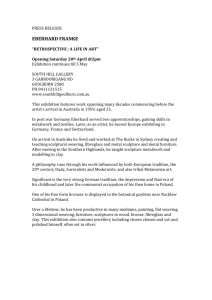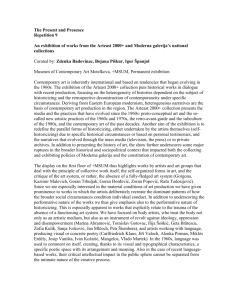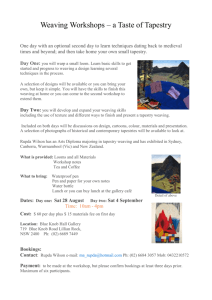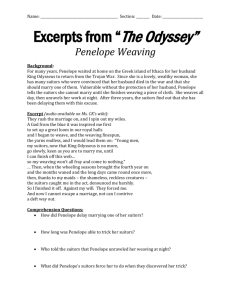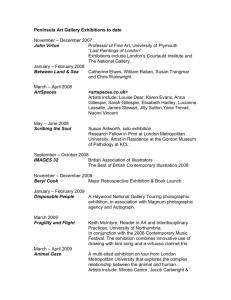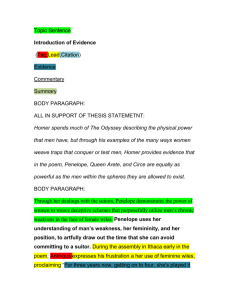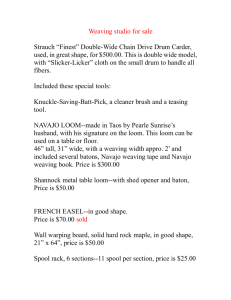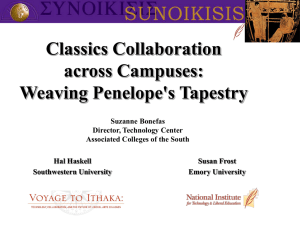Untitled - Exhibits Development Group
advertisement
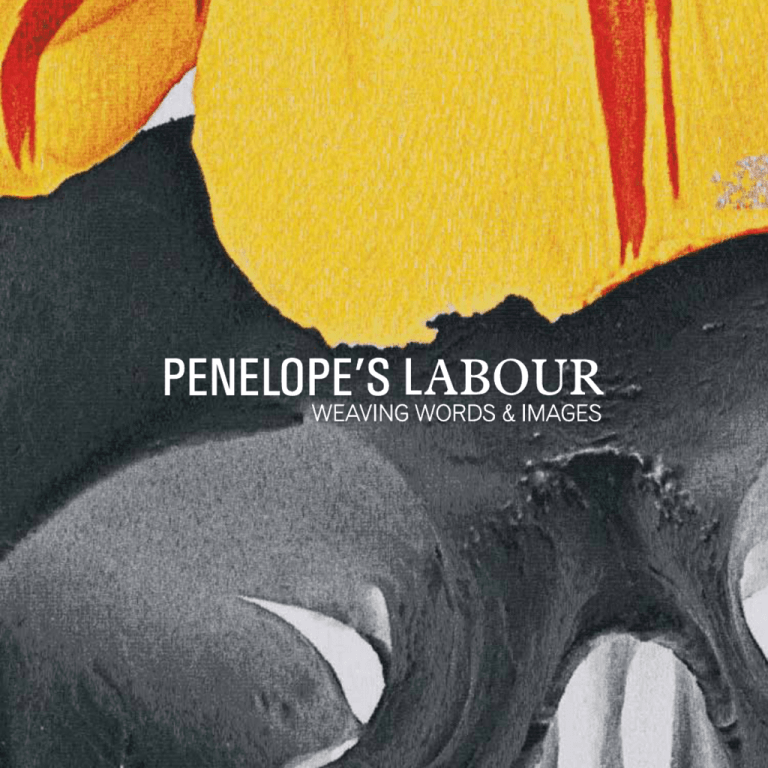
THE STORY Weaving was once one of the highest forms of artistic creation, winding its thread through western literary imagination. In Book 2 of Homer’s Odyssey, Penelope, wife of the wandering hero Odysseus, lives in mourning in Ithaca, besieged by potential suitors convinced that her husband has died in the Trojan War. Penelope is faced with a dilemma: does she accept her husband’s presumed death and marry again, or does she consign herself to perpetual mourning. She is pressured to remarry, but devises a plan to postpone her dreaded fate. Her suitors agree to let her finish weaving a shroud in honor of her husband’s father. During the day, she weaves on her loom, but every night she secretly unweaves her work, beginning again in the morning. After four years of weaving, Penelope is betrayed by her servants, and her suitors demand she complete her labor and choose among them. Over the next ten books of the Odyssey, Penelope’s labor mirrors the travels of her husband. The completion of the tapestry is subsumed into the larger narrative of Odysseus’s homecoming, the slaying of the suitors and the reunion with his faithful wife. — Extracted from catalogue text by Jerry Brotton The Exhibition Penelope’s Labour invites a reappraisal of the art of weaving. It is part of an ongoing historical reassessment of early tapestries, which in Medieval and Renaissance times weaved a distinct figurative story, related to but distinct from painting. As artists like Raphael, Rubens and Le Brun redirected the medium towards a mechanical reproduction of painting, its unique luster faded, repelling innovative collaboration and consigning tapestry to what William Morris, leader of the 19th century Arts and Crafts Movement, called “the lesser art” of craftwork. This exhibition puts that characterization to rest with its comparison of antique and contemporary tapestries and carpets, some monumental in size. Curated by Adam Lowe and Jerry Brotton, the exhibition was produced and organized by the Giorgio Cini Foundation in Venice and Factum Arte in Madrid for the Venice Biennale, where it received outstanding international acclaim. The traveling exhibition focuses on the ability of contemporary artists to use the medium of tapestry to tell varied, compelling stories from present-day life. Ranging from the significant 15th­-century tapestry, The Siege of Jerusalem, after the Master of Coëtivy, to Azra Aksamija’s collective weaving on ethnic cleansing in Bosnia Herzegovina, to Grayson Perry’s vast allegory of contemporary life and Marc Quinn’s hyper-real flowers; this exhibition brings the woven image back into the heart of contemporary artistic practice. Among others, contemporary artists in the exhibition include Lara Baladi, Alighiero Boetti, Manuel Franquelo, Carlos Garaicoa, Craigie Horsfield and Simon Peers. Brotton and Lowe have woven together an exciting new understanding of the relationship between the Jacquard loom and the computer. They demonstrate that digital weaving and innovations in new technology are allowing a wide range of contemporary artists to discover the medium in completely new ways. The artists in the exhibition are using the latest technological innovations in weaving to create a novel figurative and conceptual language of expression capable of bridging painting, performance and installation art. Exhibition Includes Twenty-five tapestries from the late 15th century and contemporary works using the latest technological innovations in weaving Exhibition catalogue available for reprint Requirements for Hosting Institution Gallery space: 10,000 square feet / 930 square meters Ceiling height: at least 13 feet / 4 meters Wall length: at least 50 feet / 15.5 meters Venue Length 12 – 24 weeks Tour Schedule Available as early as spring 2014 For Exhibition Bookings & CUratorial Questions Please contact our sales team at +1 651 222 1121 info@exhibitsdevelopment.com The Response Tapestries ancient and modern are the toast of Venice. . . “ Penelope’s Labour” is highly intelligent and beautifully displayed by the artist Adam Lowe for the Fondazione Cini. . . Don’t miss it. -- Anna Somers Cocks, The Art Newspaper A number of contemporary artists have been rediscovering weaving with amazing results, as shown by an enchanting exhibition, “Penelope’s Labor: Weaving Words and Images,” of pieces ancient and modern. -- Roderick Conway Morris, The New York Times Beautifully installed, with a poetic Arabian Nights mood to it, the show makes ancient exhibits look fresh and fresh exhibits feel ancient. Craigie Horsfield has created a dark and turbulent wall hanging that actually shows an anarchist pop concert, but feels, I swear, like a biblical crowd scene painted by Caravaggio. And Carlos Garaicoa, my favourite discovery perhaps of the entire biennale, gives us a set of brilliantly effective trompe l’oeil carpets modelled on the crumbling pavements of Havana. And to think I didn’t believe in magic carpets. -- Waldemar Januszczak, The Sunday Times e woven web. Trial 1. 2009, 160 x 60,5 cm, golden orb spider silk. nd-woven by simon peers in his workshop in madagascar. Saint Paul, MN +1 651 222 1121 tel +1 651 222 1124 fax Washington, DC +1 202 719 8073 tel +1 202 338 8182 fax
